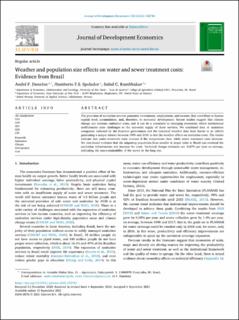Weather and population size effects on water and sewer treatment costs: Evidence from Brazil
Peer reviewed, Journal article
Published version
Permanent lenke
https://hdl.handle.net/11250/3023959Utgivelsesdato
2021-09-15Metadata
Vis full innførselSamlinger
Sammendrag
The provision of sanitation services generates investments, employment, and income; they contribute to human capital stock accumulation, and, therefore, to economic development. Recent studies suggest that climate change can increase sanitation costs, and it can be a constraint to emerging economies where institutional inefficiencies raise challenges to the universal supply of these services. We combined data of sanitation companies collected by the Brazilian government and the historical weather data from Xavier et al. (2015) generating a unique dataset between 1995 and 2016 to test the weather effects on sanitation costs. The results indicate that water treatment costs increase if the temperature rises, while sewer treatment costs decrease. We also found evidence that the migrating population from smaller to larger cities in Brazil can overload the sanitation infrastructure and increase the costs. Technical change estimates are -0.67% per year on average, indicating the non-sustainability of the sector in the long run.

